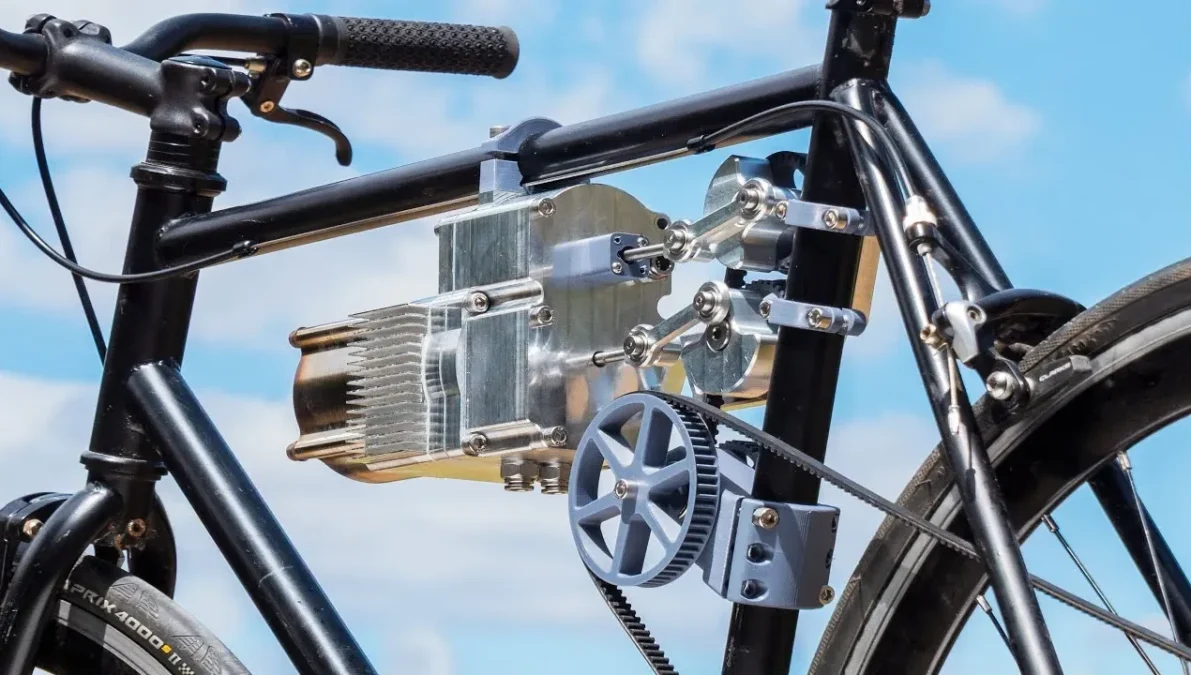
Stirling Engine Bike is the might sound like something out of a science fiction novel, but the concept is very real—and it’s powered by the ingenious design of a Stirling engine. Unlike traditional engines, which rely on combustion, the Stirling engine uses a temperature differential to create mechanical energy, offering a quieter, more sustainable alternative. Yet, adapting this technology to a bike is no small feat. From maintaining precise heat transfer to optimizing energy efficiency, the challenges are as fascinating as the solutions. This is not just a story of engineering; it’s a testament to human ingenuity and the pursuit of greener transportation.
In this project by Tom Stanton to build a Stirling engine bike, you’ll learn more about the intricate mechanics behind this unconventional power source and the innovative solutions that brought it to life. From lightweight materials to custom-designed components, every detail of the project reveals the delicate balance between creativity and practicality. You’ll also discover how overcoming obstacles like low power output and air leaks required a mix of technical expertise and bold experimentation. Whether you’re an engineering enthusiast or simply curious about the future of sustainable mobility, this journey offers a glimpse into how small-scale innovations can spark big ideas. After all, what could be more inspiring than reimagining the way we move through the world?
Stirling Engine Bike Innovation
TL;DR Key Takeaways :
- The Stirling engine operates by converting thermal energy into mechanical motion through a temperature differential, making it efficient and quiet but with relatively low power output for its size.
- Adapting a Stirling engine to power a bike involves overcoming challenges such as heat transfer, energy efficiency, weight, and durability, requiring innovative engineering solutions.
- The prototype development process highlighted the importance of iterative design, with refinements addressing inefficiencies like air leaks and suboptimal compression to achieve self-sustaining operation.
- Future enhancements, such as regenerator integration, increased internal pressure, advanced heat management, and a clutch mechanism, aim to improve the engine’s practicality and efficiency for sustainable transportation applications.
Understanding the Stirling Engine Bike
The Stirling engine operates on a fundamental principle: converting thermal energy into mechanical motion by creating a temperature differential. This is achieved through the coordinated movement of two pistons.
One of the most notable features of Stirling engines is their efficiency and quiet operation. However, they are not without limitations .Overcoming this limitation requires innovative engineering and meticulous design adjustments.
Challenges in Adapting a Stirling Engine for a Bike
Transforming a Stirling engine into a viable power source for a bike involves addressing several critical challenges:
- Heat Transfer: Maintaining a stable and sufficient temperature differential is essential for the engine’s performance. Without this, the engine cannot generate consistent power.
- Energy Efficiency: Friction and air leaks can significantly reduce efficiency. Making sure airtight seals and minimizing mechanical resistance are crucial to optimizing performance.
- Weight and Durability: The engine must be lightweight enough to integrate seamlessly with the bike while being durable enough to withstand prolonged use and varying conditions.
Building a Stirling Engine Bike
Innovative Engineering Solutions
- Improved Heat Transfer: A water cooling system was introduced to maintain the necessary temperature differential, making sure consistent and reliable engine operation.
- Lightweight Materials: Heat-resistant aluminum alloys were used for key components such as pistons and displacers. This reduced the engine’s weight without compromising its structural integrity.
- Airtight Seals: Custom-designed piston rings were developed to minimize air leaks, improving compression and overall energy efficiency.
These solutions not only addressed the immediate technical challenges but also provided a foundation for further refinements and improvements.
Building and Testing the Prototype
The construction phase involved precision machining and careful assembly of critical components, including the engine block, pistons, and crankshaft.
Although the prototype’s power output remained modest, these refinements demonstrated the engine’s potential for practical applications.
Future Enhancements and Potential Applications
While the current prototype represents a significant achievement, further advancements are necessary to improve the engine’s performance and efficiency. Planned upgrades include:
- Regenerator Integration: Adding a regenerator to recycle heat energy, which would significantly increase the engine’s thermal efficiency.
- Increased Internal Pressure: Boosting the engine’s internal pressure to enhance its power output and overall performance.
- Advanced Heat Management: Developing a more efficient burner and radiator system to ensure sustained and reliable operation over extended periods.
- Clutch Mechanism: Incorporating a clutch system to seamlessly connect the engine to the bike’s drivetrain, improving usability and control.
These planned improvements aim to make the Stirling engine bike more practical and efficient, paving the way for broader applications in sustainable transportation.
The Broader Implications of Stirling Engine Technology
The Stirling engine bike project exemplifies the challenges and rewards of adapting innovative technologies for real-world applications.This project not only highlights the versatility of Stirling engines but also serves as an inspiration for further exploration into eco-friendly transportation solutions. As advancements continue, the Stirling engine could play a pivotal role in reducing reliance on fossil fuels and promoting greener alternatives in the transportation sector.
Also Like This Software !!!! Download Link